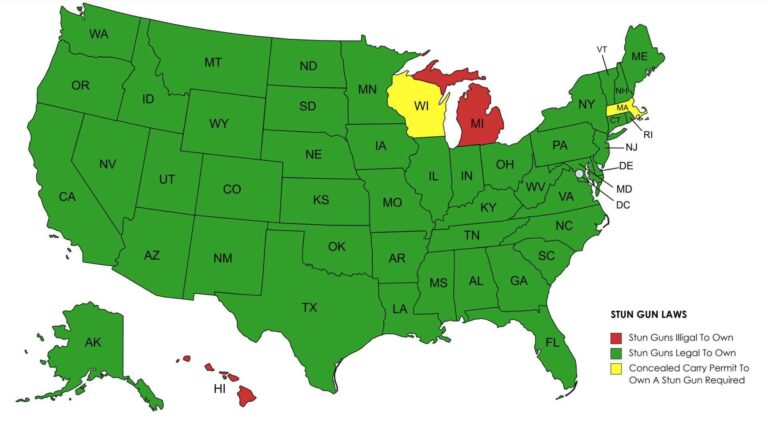Table of Contents
- Connecticut Stun Gun Regulations Overview and Legal Definitions
- Understanding Age Restrictions for Stun Gun Ownership in Connecticut
- Permit Requirements and Application Process for Stun Gun Carriers
- Practical Recommendations for Compliance and Safe Use of Stun Guns in Connecticut
- Final Thoughts
Connecticut Stun Gun Regulations Overview and Legal Definitions
In Connecticut, the legal landscape surrounding stun guns is shaped by explicit statutes that classify these devices as potentially dangerous weapons. Notably, the state law defines stun guns as electronic control devices designed to incapacitate a person temporarily through electric shock. This classification places specific boundaries on ownership and use, ensuring that these devices serve legitimate self-defense purposes without becoming tools for unlawful activities. Understanding these legal definitions is crucial for responsible ownership and compliance with state regulations.
Key regulatory points include:
- Ownership is generally restricted to those aged 18 and older, emphasizing responsible use by adults.
- No special permit or license is required to possess or carry a stun gun, which simplifies acquisition for law-abiding residents.
- Use of stun guns in commission of a crime or against law enforcement officials can result in enhanced penalties under state law.
- Prohibition of carrying stun guns on certain premises, including schools and government buildings, ensures public safety in sensitive environments.
Understanding Age Restrictions for Stun Gun Ownership in Connecticut
In Connecticut, the possession of stun guns is subject to clear age limitations, designed to enhance public safety while balancing self-defense rights. Individuals must be at least 18 years old to legally purchase or carry a stun gun. This age threshold aligns with other weapon-related statutes in the state, ensuring that juveniles are restricted from acquiring devices that can cause significant harm. Retailers and gun sellers are mandated to verify the age of their customers, a crucial step in compliance with state law.
Additionally, there are specific conditions under which minors might face legal consequences if found in possession of a stun gun. These rules are cemented to discourage underage access and use. Key points to keep in mind include:
- Zero tolerance policies exist for selling or giving stun guns to anyone under 18.
- Possession by minors can lead to criminal charges, including potential misdemeanor violations.
- Court rulings emphasize strict enforcement of age restrictions to prevent misuse.
Permit Requirements and Application Process for Stun Gun Carriers
In Connecticut, carrying a stun gun requires obtaining a permit that ensures responsible ownership and use. Applicants must be at least 18 years old and demonstrate a legitimate need to carry a stun gun for personal protection. The application process is handled through the local police department or state police, depending on the applicant’s residence. It’s essential to submit a fully completed application form accompanied by a valid photo ID and proof of residency.
Once the application is submitted, the process may include a background check and an in-person interview or fingerprinting. Applicants should be prepared to provide:
- Personal identification documents
- Proof of Connecticut residency
- Details explaining the necessity of carrying a stun gun
Approval discretion rests with the law enforcement authorities, who prioritize public safety and responsible use. Permit holders are expected to comply with strict regulations regarding how and where the stun guns can be carried, making it crucial to fully understand the responsibilities associated with possession.
Practical Recommendations for Compliance and Safe Use of Stun Guns in Connecticut
To ensure lawful ownership and operation, individuals should first verify they meet Connecticut’s minimum age requirement of 18 years before purchasing or carrying a stun gun. Additionally, owners must always keep their devices concealed and avoid carrying them in restricted areas such as federal buildings, schools, and private properties that explicitly prohibit stun guns. Taking time to review local ordinances beyond state law is crucial, as municipalities may have additional restrictions that affect where and how these weapons can be carried or used.
When handling a stun gun, always prioritize safety by regularly inspecting the device for damage and ensuring it is fully charged. Training on proper usage not only minimizes accidental injury but also strengthens your ability to deploy it responsibly during a legitimate self-defense situation. Carry the stun gun in a secure holster or case to prevent unintentional discharge, and never brandish or demonstrate the weapon in public without justifiable cause. Following these guidelines protects you legally and helps maintain public trust in the responsible use of less-lethal defense tools.
- Confirm legal age and state-specific carry restrictions
- Store and transport stun guns concealed and securely
- Avoid carrying in prohibited places like schools or federal buildings
- Maintain and inspect the stun gun frequently for safety
- Acquire proper training to ensure effective, responsible use
Final Thoughts
In conclusion, understanding Connecticut’s stun gun laws is essential for anyone considering these self-defense tools. The state’s regulations, including age restrictions and permit requirements, are designed to ensure responsible possession and use. By familiarizing yourself with these rules, you can stay compliant and protect yourself within the bounds of the law. Always remember to check for any updates or changes in legislation, and when in doubt, consult local authorities or legal experts. Staying informed is the first step toward safe and lawful self-defense.Check Our Other Blogs
- StunGun – Your Trusted Source for Stun Guns, Laws, and Self-Defense Tips
- PepperSprayLaws – Your Trusted Resource for Pepper Spray Information
- StunGunLaws – Your Trusted Guide to Stun Gun Legality and Safety





